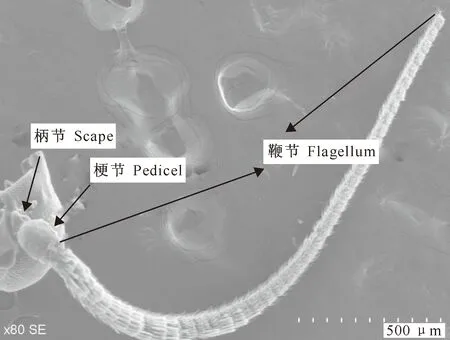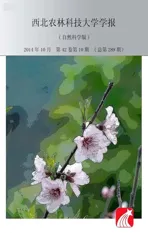梨小食心虫触角感器的超微结构
2014-03-26张国辉宋月芹田晓丽仵均祥
张国辉,宋月芹,田晓丽,仵均祥
(1西北农林科技大学 植物保护学院 植保资源与病虫害治理教育部重点实验室,应用昆虫学重点实验室,陕西 杨凌 712100; 2 长江大学 生命科学学院,湖北 荆州 434025)
触角是昆虫感受外界环境的重要器官,具有嗅觉、味觉和触觉等功能,在昆虫求偶交配、定位寄主及寻找产卵场所和躲避危险等行为过程中发挥着重要作用[1-2]。触角的功能主要通过其表面着生的各种感器来实现,昆虫触角感器类型众多,结构和功能也不尽相同,且在不同昆虫种类间差异很大[3]。明确昆虫触角感器的类型、形态、数量和分布,是探索昆虫行为调控机制的必要前提。
梨小食心虫Grapholitamolesta(Busck) 属鳞翅目(Lepidoptera)卷蛾科(Tortricidae),是一种严重危害桃、梨等果树的世界性重要害虫,在我国广泛分布于除西藏以外的所有省、市、自治区[4]。近年来,由于农业产业结构的调整,果树栽培模式和管理措施的变化等因素的影响,梨小食心虫在我国许多地方大面积发生[4-5],虫果率一般达30%~40%,个别果园虫果率甚至高达80%以上[6]。梨小食心虫在桃、梨混栽果区发生为害尤为严重[7-8],给果业生产造成了巨大的经济损失,已成为制约梨、桃等果树优质、高产栽培的重要因素之一。
梨小食心虫一年发生多代,存在典型的季节性寄主转移现象[9-10]。研究发现,信息化合物在调节食心虫寄主选择过程中起着关键作用[11]。因此,探明梨小食心虫与外界信息化合物的化学通讯机制,对探索梨小食心虫的行为调控措施有重要意义。为此,本研究对梨小食心虫的触角感器超微结构进行了观察,以期深入了解其化学感受系统,为揭示梨小食心虫寄主选择行为机制奠定基础。
1 材料与方法
1.1 供试昆虫
梨小食心虫成虫由西北农林科技大学农业害虫综合治理研究室提供。成虫期饲喂体积分数10%蜂蜜水,幼虫期饲喂人工饲料[12]。饲养条件如下:温度(24±0.5) ℃、相对湿度(70±10)%、光周期为15 h(L)∶9 h(D)。
1.2 试验方法
取当天羽化的梨小食心虫雌、雄成虫各10头,在解剖镜下用手术刀将触角整体取下,放入盛有体积分数75%乙醇的样品瓶中,超声清洗20 s,并用0.1 mol/L磷酸缓冲液(pH 7.4)清洗3~4次,每次10 min。再分别用体积分数80%,90%,95%和无水乙醇溶液梯度脱水处理2次,每次5 min。乙醇脱水干燥后,将各触角样品分别用导电银胶固定于样品台上,用离子溅射仪进行喷金后,在日立S-3400型扫描电镜下进行观察、拍照。触角感器的鉴定主要参照Schneider[3]的标准进行。
2 结果与分析
2.1 梨小食心虫触角的一般形态及感器种类
梨小食心虫雌、雄成虫触角均呈丝状,由柄节(Scape)、梗节(Pedicel)和鞭节(Flagellum)3部分构成(图1)。触角柄节短小,长48.4~53.7 μm;梗节膨大,长114.1~120.3 μm;鞭节由40~45亚节构成,长2 130~2 450 μm;两性间触角形态无明显差异,触角总长2.3~2.7 mm。梨小食心虫触角自基部向端部逐渐变细,分为背面和腹面,背面着生大量规则排列的鳞片,触角感器多分布于腹面。通过扫描电镜观察发现,梨小食心虫触角上共存在7种感器,且每种感器的形态和数量在两性间无明显差异,7种感器分别为毛形感器、锥形感器、刺形感器、栓锥形感器,腔锥形感器、耳形感器、Böhm氏鬃毛。

图1 梨小食心虫成虫触角的形态(×80)
2.2 梨小食心虫触角感器的超微结构
2.2.1 毛形感器(Sensilla trichodea,Str) 毛形感器是梨小食心虫触角表面分布最广、数量最多的一类感器,主要分布于触角鞭节的各亚节腹面,呈细长毛发状,着生于触角表皮毛窝中。梨小食心虫触角上的毛形感器有StrⅠ (图2-1)和StrⅡ(图2-2)2种类型,StrⅠ型基部直径1.5~2.0 μm,长27.8~33.4 μm,与触角表面约成60 ℃倾斜,稍呈孤形弯曲,由基至端部逐渐变细;StrⅡ型基部直径1.6~1.9 μm,长17.2~23.7 μm,在近基部处向触角端部方向近90 ℃弯曲,感器弯曲部分与触角表面几乎平行,向顶端逐渐变细。
2.2.2 锥形感器(Sensilla basiconica,Sba) 锥形感器端部钝圆,基部无突起的臼状窝,比毛形感器粗短。梨小食心虫锥形感器有SbaⅠ (图2-3)和SbaⅡ(图2-4) 2种类型,分布于触角鞭节腹面。SbaⅠ型呈短剌状,基部直径1.9~2.2 μm,长13.2~15.1 μm,向端部逐渐变细;SbaⅡ型基部直径1.3~1.6 μm,长8.4~10.3 μm,在近基部处呈大于90°的弯曲,向顶端逐渐变细。
2.2.3 刺形感器(Sensilla chaetica, Sch) 刺形感器细长如刺,刚直挺立,较毛形感器粗壮,基部直径2.1~2.3 μm,长度变化较大,为22.4~42.2 μm,基部有一向上隆起的臼状窝,分布于触角鞭节的腹面,每亚节3个(图2-5和图2-6)。
2.2.4 栓锥形感器(Sensilla styloconica,Sst) 栓锥形感器是梨小食心虫触角中最粗壮的一类感器,呈拇指状,基部直径4.3~5.2 μm,长18.3~19.6 μm,顶端有一小锥形突起,分布于触角鞭节的各亚节腹面前缘,每亚节1个(图2-6)。
2.2.5 腔锥形感器(Sensilla coeloconica,Sco) 腔锥形感器为一类触角表皮凹陷而形成的感器,一般分为无缘毛腔锥形感器和具缘毛腔锥形感器2种。梨小食心虫触角上的主要为具缘毛腔锥形感器,主要分布于触角鞭节各亚节远端,常几个聚在一起,形状极像菊花,中间为一直立的感觉锥,周围缘毛向中心聚拢(图3-1~4)。

图3 梨小食心虫成虫触角的腔锥形感器、耳形感器和Böhm氏鬃毛
2.2.6 耳形感器(Sensilla auricillica,Sau) 耳形感器呈兔耳状,表面凹陷,类似于卷曲的禾本科植物心叶,长10.1~18.3 μm,最大宽度2.0~3.5 μm,着生于触角表皮特化的窝内,分布于触角鞭节各亚节远端(图3-1~4)。
2.2.7 Böhm氏鬃毛(Böhm bristles,Bbr) Böhm氏鬃毛呈短刺型,较刺形感器短小,表面光滑,基部直径1.1~1.4 μm,长3.3~6.1 μm,成群分布于触角柄节和梗节基部(图3-5~6)。
3 讨 论
本研究结果显示,梨小食心虫触角主要有7种感器:毛形感器、锥形感器、刺形感器、栓锥形感器、腔锥形感器、耳形感器和Böhm氏鬃毛,其中毛形感器和锥形感器各有2种类型,与鳞翅目其他昆虫触角感器的类型[13-15]比较相似,与已报道的卷蛾科其他昆虫触角感器类型也十分相似[16-17]。
毛形感器和锥形感器是研究较多的2类昆虫触角感器,它们在昆虫与外界进行化学通讯中发挥着重要作用。毛形感器是昆虫触角上分布最广、数量最多的感器。对植食性昆虫而言,毛形感器是感受昆虫性信息素的主要器官[18-19],同时毛形感器也具有感受寄主植物挥发物的功能[20]。锥形感器具有丰富的小孔,其内有神经细胞;锥形感器属于嗅觉感器,能感受植物气味[21-22],推测其还具有感受昆虫性信息素的作用[23-24]。本研究中,梨小食心虫触角上存在2种类型的毛形感器(StrⅠ和StrⅡ)和2种类型的锥形感器(SbaⅠ和SbaⅡ),这2类感器应该与梨小食心虫感受自身性信息素和寄主挥发物有关,然而这几种感器具体感受何种信息素组分,还需进一步研究。
本研究发现,梨小食心虫的刺形感器和栓锥形感器常直立着生于触角各鞭节表面,明显长于其他感器,处于最先接触外界物质的部分,因而认为刺形感器是一种感受外部刺激的机械性感器[25],而栓锥形感器用于感受外物的温度和湿度变化[26]。然而也有研究表明,刺形感器和栓锥形感器顶端均具孔,且内部都有神经元支配,可行使嗅觉功能[27-28]。本研究在梨小食心虫刺形感器和栓锥形感器顶端均未观察到小孔,推测刺形感器应具有感受机械刺激的功能,栓锥形感器应主要行使感受温度和湿度变化的功能。
本研究发现,梨小食心虫的腔锥形感器和耳形感器均主要分布于触角各鞭节远端,且常几个聚在一起。研究表明,此2种感器主要与昆虫感受气味分子有关,腔锥形感器可感受湿度、二氧化碳及植物气味等的变化[29-32];耳形感器与昆虫感受植物挥发物有关,如棘翅夜蛾Scoliopteryxlibatrix[33]和苹果蠹蛾Cydiapomonella[34]的耳形感器均会对植物挥发物产生行为反应。据此推测,与苹果蠹蛾同科的昆虫梨小食心虫的耳形感器可能也具相同的功能。
本研究中,梨小食心虫Böhm氏鬃毛主要分布于触角柄节和梗节基部,其被认为是一种感受重力的机械感器[12]。在许多昆虫中,Böhm氏鬃毛均成群分布于头与触角柄节及触角柄节与梗节连接部位,可感受触角的位置和运动[24]。
上述各种感器中,除Böhm氏鬃毛外,笔者推测其他6种感器可能与感受外界环境的化学信息有关,证明昆虫化学感受系统十分复杂,参与昆虫化学通讯的感器是多样的,且他们各自感受的化学信息可能有所不同。本研究基于前人对其他昆虫触角感器的结果,对梨小食心虫触角感器功能进行了推测,发现毛形感器、锥形感器、腔锥形感器及耳形感器应与该虫化学感受有关。今后,将用昆虫电生理和分子生物学技术对梨小食心虫触角感器功能进行进一步研究,以期深入了解其化学感受系统,为揭示梨小食心虫复杂的化学感受机制及其寄主选择行为机制奠定基础。
[参考文献]
[1] Clyne P,Grant A,O’ Connell R,et al.Odorant response of individual sensilla on theDrosophilaantenna[J].Invertebrate Neuroscience,1997,3:127-135.
[2] 严善春,张丹丹,迟德富.植物挥发物质对昆虫作用的研究进展 [J].应用生态学报,2003,14(2):310-313.
Yan S C,Zhang D D,Chi D F.Advances of studies on the effects of plant volatiles on insect behavior [J].Chinese Journal of Applied Ecology,2003,14(2):310-313.(in Chinese)
[3] Schneider D.Insect antennae [J].Annual Review of Entomology,1964,9:103-122.
[4] 陆鹏飞,黄玲巧,王琛柱.梨小食心虫化学通信中的信息物质 [J].昆虫学报,2010,53(12):1390-1403.
Lu P F,Huang L Q,Wang C Z.Semiochemicals used in chemical communication in the oriental fruit moth,GrapholithamolestaBusck (Lepidoptera:Tortricidae) [J].Acta Entomologica Sinica,2010,53(12):1390-1403.(in Chinese)
[5] 马之胜,贾云云,王越辉,等.桃园梨小食心虫发生规律研究进展 [J].江西农业学报,2012,24(10):59-61.
Ma Z S,Jia Y Y,Wang Y H,et al.Research progress in occurrence regularity of oriental fruit moth in peach orchard [J].Acta Agriculturae Jiangxi,2012,24(10):59-61.(in Chinese)
[6] 冯晓洁,刘艳涛,席国成,等.河北鸭梨产区梨小食心虫发生动态及防治研究 [J].河北农业科学,2012,16(7):48-50.
Feng X J,Liu Y T,Xi G C,et al.Research on occurrence oynamic and orevention and cure ofGraphplithamolestain Yali pear producing area of Hebei [J].Journal of Hebei Agricultural Sciences,2012,16(7):48-50.(in Chinese)
[7] Pinero J C,Dorn S.Response of female oriental fruit moth to volatiles from apple and peach trees at three phonological stages [J].Entomologia Experimentails et Applicata,2009,131(1):67-74.
[8] Najar-Rodriguez A,orschel B,Dorn S.Season-long volatile emissions from peach and pear trees in Situ,overlapping profiles,and olfactory attraction of an oligophagous fruit moth in the laboratory [J].Journal of Chemical Ecology,2013,39:418-429
[9] Natale D,Mattiacci L,Hern A,et al.Response of femaleCydiamolesta(Lepidoptera:Tortricidae) to plant derived volatiles [J].Bulletin of Entomological Research,2003,93:335-342.
[10] 赵忠仁,王元珪,颜桂英.苏北地区梨小食心虫研究初报 [J].昆虫知识,1989,26(1):106-116.
Zhang Z R,Wang Y G,Yan G Y.The first report aboutGrapholithamolestain northern Jiangsu area [J].Chinese Bulletin of Entomology,1989,26(1):106-116.(in Chinese)
[11] Masante-Roca I,Anton S,Delbac L,et al.Attraction of the grapevine moth to host and non-host plant parts in the wind tunnel:Effects of plant phenology,sex,and mating status [J].Entomologia Experimentails et Applicata,2007,122(3):239-245.
[12] 杜 娟,王艳蓉,仵均祥.不同饲料配方对梨小食心虫生长发育及繁殖的影响 [J].山西农业大学学报:自然科学版,2010,30(3):229-231.
Du J,Wang Y R,Wu J X.Effect of four different artificial diets on development and reproduction ofGrapholithamolesta(Lepidoptera:Tortricidae) [J].Journal of Shanxi Agricultural University:Nature Science Edition,2010,30(3):229-231.(in Chinese)
[13] 宫田睿,李新岗,杨立军,等.桃小食心虫触角感受器扫描电镜观察 [J].西北农林科技大学学报:自然科学版,2012,40(6):121-124.
Gong T R,Li X G,Yang L J,et al.Ultrastructural observations of antennal sensilla ofCarposinaniponensisWalsingham (Lepidoptera:Carposinidae) [J].Journal of Northwest A&F University:Nature Science Edition,2012,40(6):121-124.(in Chinese)
[14] 邵淑霞,姜 波,蒲卫琼,等.井上蛀果斑螟触角感受器的扫描电镜观察 [J].昆虫知识,2008,45(6):932-936.
Shao S X,Jiang B,Pu W Q,et al.Observations on antennal sensilla ofAssarainoueiwith scanning electron microscopy [J].Chinese Bulletin of Entomology,2008,45(6):932-936.(in Chinese)
[15] 王桂荣,郭予元,吴孔明.棉铃虫触角感器的超微结构观察 [J].中国农业科学,2002,35(12):1479-1482.
Wang G R,Guo Y Y,Wu K M.Observation on the ultrastructures of antennal sensilla inHelicoverpaarmigera[J].Scientia Agricultura Sinica,2002,35(12):1479-1482.(in Chinese)
[16] 杨 啸,赵奎军,王克勤,等.大豆食心虫触角感器的扫描电镜观察 [J].应用昆虫学报,2012,49(5):1321-1326.
Yang X,Zhao K J,Wang K Q,et al.Observation on antennal sensillia ofLeguminivoraglycinivorellawith scanning electron microscope [J].Chinese Journal of Applied Entomology,2012,49(5):1321-1326.(in Chinese)
[17] 赵 骁,张雅林,冯纪年.苹果蠹蛾成虫触角感器的超微结构观察 [J].西北农林科技大学学报:自然科学版,2012,40(11):120-123.
Zhao X,Zhang Y L,Feng J N.Ulyrastructural observation on antennal sensilla of the adult codling moth,Cydiapomonella(L.) (Lepidoptera:Tortricidae) [J].Journal of Northwest A&F University:Nature Science Edition,2012,40(11):120-123.(in Chinese)
[18] 吴才宏.棉铃虫雄蛾触角的毛形感器对其性信息素组分及类似物的反应 [J].昆虫学报,1993,36(4):385-389.
Wu C H.Responses from Sensilla on the antennae of maleHeliothisarmigerato its sex pheromone components and analogs [J].Acta Entomologica Sinica,1993,36(4):385-389.(in Chinese)
[19] Chinta S,Dickens J C,Baker G T.Morphology and distribution of antennal sensilla of the tarnished plant bug,Lyguslineolaris(Palisot de Beauvois) (Hemiptera:Miridae) [J].International Journal of Insect Morphology and Embryology,1997,26(1):21-26.
[20] Shields V D C,Hildebrand J G.Responses of a population of antennal olfactory receptor cells in the female mothManducasextato plant-associated volatile organic compounds [J].Journal of Comparative Physiology,2001,186(12):1135-1151.
[21] Consoli F L,Kitajima E W,Parra J R P.Sensilla on the antenna and ovipositor of the parasitic waspsTrichogrammagalloiZucchi andT.PretiosumRiley (Hym.,trichogrammatidae) [J].Microscopy Research and Technique,1999,45(4/5):313-324.
[22] Bleeker M A K,Smid H M,van Aelst A C,et al.Antennal sensilla of two parasitoid wasps:A comparative scanning electron microscopy study [J].Microscopy Research and Technique,2004,63(5):266-273.
[23] Merivee E,Rahi M,Luik A.Antennal sensilla of the click beetle,Melanotusvillosus(Geoffroy) (Coleoptera:Elateridae) [J].International Journal of Insect Morphology and Embryology,1999,28(1/2):41-51.
[24] Zhang J,Guan L,Ren B Z.Fine structure and distribution of antennal sensilla of longicorn beetlesLepturaarcuataPanzer andLepturaaethiopsPoda (Coleoptera:Cerambycidae) [J].Annals of the Entomological Society of America,2011,104(4):778-787.
[25] Tarumingkeng R C,Coppel H C,Matsumura F.Morphology and ultrastructure of the antennal chemoreceptors and mechanoreceptors of workerCoptotermesformosanusShiraki [J].Cell and Tissue Research,1976,173(2):173-178.
[26] Hallberg E,Hansson B S,Steinbrecht R A.Morphological ch-aracteristics of antennal sensilla in the European corn borerOstrinianubilalis(Lepidoptera:Pyralidae) [J].Tissue Cell,1994,26(4):489-502.
[27] Altner H,Sas H,Altner L.Relationship between structure and function of antennal chemo-,hygro- and thermo-receptive sensilla inPeriplanetaAmericana[J].Cell and Tissue Research,1977,176(3):389-405.
[28] Albert P J,Seabrook W D.Morphology and histology of the antenna of the male eastern spruce budworm,Choristoneurafumiferana (Clem.) (Lepidoptera:Tortricidae) [J].Canadian Journal of Zoology,1973,51(4):443-448.
[29] Davis E E,Sokolove P G.Temperature responses of antennal receptor of the mosquitoAedesaegypti[J].Journal of Comparative Physiology,1975,96(3):223-236.
[30] White P R,Reginald F,Chapman T.Tarsal chemoreception in the polyphagous grasshopperSchistocercaAmericana:Behavioral assays,sensilla distributions and electrophysiology [J].Physilogical Entomology,1990,15(1):105-121.
[31] Ochieng S A,Hallberg E,Hasson B S.Fine structure and distribution of antennal sensilla of the desert locustSchistocercagregaria(Orthoptera:Acrididae) [J].Cell and Tissue Research,1998,291(3):525-536.
[32] Bruce T J,Cork A.Electrophysiological and behavioral responses of femaleHelicoverpaarmigerato compounds identified in flowers of African marigold Tagetes erecta [J].Journal of Chemical Ecology,2001,27(6):1119-1131.
[33] Anderson P,Hallberg E,Subchev M.Morphology of antennal sensilla auricillica and their detection of plant volatiles in the herald moth,ScoliopteryxlibatrixL.(Lepidoptera:Noctuidea) [J].Arthropod Structure and Development,2000,29(1):33-41.
[34] Ansebo L,Ignell R,Löfqvist J,et al.Responses to sex pheromone and plant odours by olfactory receptor neurons housed in sensilla auricillica of the coding moth,Cydiapomonella(Lepidoptera:Totricidae) [J].Journal of Insect Physiology,2005,51(10):1066-1074.
